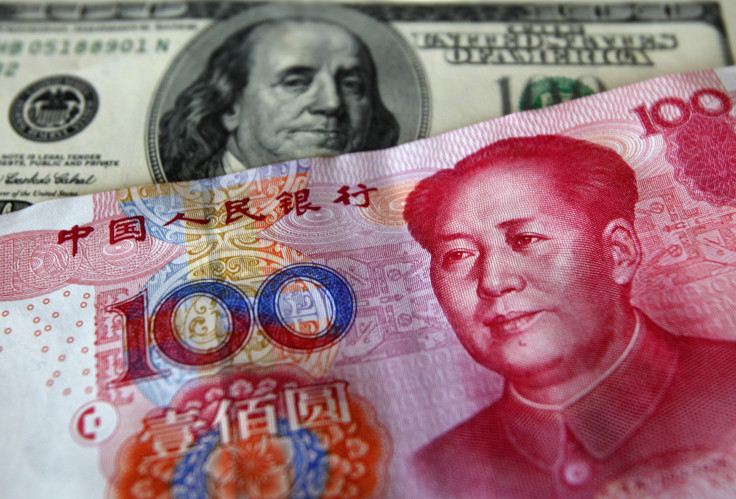China Currency: Continuing Slide Shows Beijing’s Dilemma In Managing Decline

The continuing slide of the Chinese currency is fortifying the impression that Beijing doesn’t have a strategy for managing the renminbi’s depreciation, creating new risks for a global economy already reeling from the dramatic slowdown of the world’s second-largest economy. Now the only question is: How will China respond?
The renminbi weakened for the third straight day Wednesday in trading in mainland China to about 6.55 to the dollar, with no end in sight, raising the prospect of the kind of depreciation that roiled financial markets in August. The currency was even weaker in offshore markets, an indicator that investors are ready to sell more if they can. Earlier, the currency sank to a five-year low against the U.S. dollar.
Brad Setser, a senior fellow at the Council on Foreign Relations, said the dominant question in Chinese currency policy is whether China can handle an orderly depreciation in the face of relentless market pressure -- from inside and outside China -- to move more quickly.
“The Chinese have historically placed a great value on stability,” Setser, who recently left a senior position at the U.S. Treasury Department, said. “That desire for stability balances against the various forces that are pushing toward a weaker currency.”
The continuing pressure on the currency poses a dilemma of policy choices for Beijing. If the People’s Bank of China wants to halt the decline, it can use its war chest of about $3.4 trillion in foreign currency reserves to defend the renminbi, also referred to as the yuan.
But that course of action risks a test of wills with markets, which have forced the central bank to spend down reserves from a peak of about $4 trillion in mid-2014. China has quite a stash, but governments seldom win against a determined market, and it’s not clear how many dollars China has to spend, since the composition of the reserves is unknown.
About a quarter-trillion dollars left the country in the last three months of 2015, suggesting currency outflows are accelerating, as investors seek better opportunities outside of the country.
The opposite policy course — letting the renminbi depreciate until investors start buying again and put a floor under it the currency — is a leap into the unknown. China manages its exchange rate by setting a midpoint around which the currency is allowed to fluctuate each day, and abandoning that approach would relinquish the government’s control entirely, always a dicey proposition in one-party China.
Further complicating Beijing’s situation: the decline is probably being driven by mainland Chinese investors and companies.
China has controls on capital leaving the country, but they aren’t absolute. No one knows precisely who is moving money out, but the likely candidates are Chinese companies and investors that have a reason and a means to sell renminbi for dollars. By swapping renminbi for dollars, they can diversify portfolios and hold assets in jurisdictions where the rule of law (and, therefore, the safety of their assets) is much stronger.
“They not only might want to be out of domestic financial markets right now, they also can see an existing productive use for the money elsewhere that won’t necessarily draw attention as abandonment of the motherland,” said Derek Scissors, an Asian economics specialist at the American Enterprise Institute.
There’s also a strong constituency that would benefit from a sharper depreciation of the renminbi: the exporters who have turned China into a global manufacturing powerhouse over the last 20 years.
China now aims for growth of about 6.5 percent annually, far off the 10 percent it used to achieve, although still a healthy clip. If it dips much further, Beijing could decide that the benefits of letting the currency drop -- a boost to exports -- sharply outweigh the risks. That, in turn, would delay the long-awaited shift of the Chinese economy away from exports and toward a more consumer-driven market.
“Growth below the authorities’ official targets could again spook global financial markets,” Maury Obstfeld, the head of research at the International Monetary Fund, wrote in a recent report. “But then again, time-honored methods of enforcing growth targets could simply extend economic imbalances, spelling possible trouble down the road.”
That, in turn, raises the possibility of further conflict with the United States.
The U.S. trade deficit hit $42.4 billion in November, according to data released today. That's slightly smaller than the previous month, but still enough to be a drag on growth, according to Jim O’Sullivan, chief U.S. economist at High Frequency Economics.
Lawmakers in the U.S. Congress will hold a hearing tomorrow on exchange rates, at which China’s behavior is likely to be a subject of debate. Congress has long sought legislation that would penalize China over its currency policies, something President Barack Obama, and administrations before him, have blocked.
© Copyright IBTimes 2024. All rights reserved.











